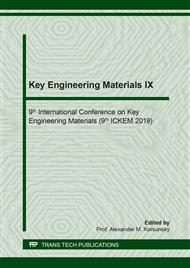[1]
Y. Tang, L. Pang and D. Wang, Preparation and characterization of borate bioactive glass cross-linked PVA hydrogel, J Non-Cryst Solids, Vol. 476, pp.25-29, (2017).
DOI: 10.1016/j.jnoncrysol.2017.07.017
Google Scholar
[2]
S. Spoljaric, A. Salminen, N. Dang Luong and J. Seppälä, Stable, self-healing hydrogels from nanofribrillated cellulose, polyvinyl alcohol and borax via reversible crosslinking, Eur Polym J, Vol. 56, pp.105-117, (2014).
DOI: 10.1016/j.eurpolymj.2014.03.009
Google Scholar
[3]
S. Pooley, B. Rivas, F. Lillo and G. Pizarro, Hydrogels from acrylic acid with N,N-dimethylacrylamide: synthesis, charcaterization and water absorption properties, J Chil Chem Soc, Vol. 55, pp.19-24, (2010).
DOI: 10.4067/s0717-97072010000100006
Google Scholar
[4]
K. Chen, J. Liu, X. Yang and D. Zhang, Preparation, optimization and property of PVA-HA/PAA composite hydrogel, Mater Sci Eng C, Vol. 78, pp.520-529, (2017).
DOI: 10.1016/j.msec.2017.04.117
Google Scholar
[5]
B. Ratner, A. Hoffman, F. Schoen and J. Lemons: Biomaterials Science: An Introduction to Materials in Medicine, pp.60-64, (1996).
Google Scholar
[6]
E. Ahmed, Hydrogel: preparation, characterization and applications; a review, J Adv Res, Vol. 6, pp.105-121, (2013).
Google Scholar
[7]
D.S. Deshpande, R. Bajpai and A.K. Bajpai, Synthesis and characterization of polyvinyl alcohol based semi interpenetrating polymeric networks, J Polym Res, Vol. 19, No. 8, pp.9938-9946 (2012).
DOI: 10.1007/s10965-012-9938-x
Google Scholar
[8]
X. Li, Y. Jiang, F. Wang, Z. Fan, H. Wang, C. Tao and Z. Wang, Preparation of polyurethane/polyvinyl alcohol hydrogel and its performance enhancement via compositing with silver particles , RSC Adv, Vol. 7, No. 73, p.46480–46485, (2017).
DOI: 10.1039/c7ra08845k
Google Scholar
[9]
J.M. Lee, M.T. Sultan, S.H. Kim, V. Kumar, Y.K. Yeon, O.J. Lee and C.H. Park, Artificial Auricular Cartilage Using Silk Fibroin and Polyvinyl Alcohol Hydrogel, Int J Mol Sci, Vol. 18, pp.1-15, (2017).
DOI: 10.3390/ijms18081707
Google Scholar
[10]
Y.N. Chen, L. Peng, T. Liu, Y. Wang, S. Shi and H. Wang, Poly(vinyl alcohol)–Tannic Acid Hydrogels with Excellent Mechanical Properties and Shape Memory Behaviors, ACS Appl Mater Interfaces, Vol. 8, No. 40, p.27199–27206, (2016).
DOI: 10.1021/acsami.6b08374
Google Scholar
[11]
D. Bodas and C. Khan-Malek, Formation of more stable hydrophilic surfaces of PDMS by plasma and chemical treatments, Microelectron Eng, Vol. 83, No. 4–9, p.1277–1279, (2006).
DOI: 10.1016/j.mee.2006.01.195
Google Scholar
[12]
A. Sannino, C. Demitri and M. Madaghiele, Biodegradable cellulose-based hydrogels: design and applications, Materials, Vol. 2, pp.353-373, (2009).
DOI: 10.3390/ma2020353
Google Scholar
[13]
C. Masri, G. Chagnon and D. Favier, Influence of processing parameters on the macroscopic mechancial behavior of PVA hydrogels, Mater Sci Eng C, Vol. 75, pp.769-776, (2017).
DOI: 10.1016/j.msec.2017.02.045
Google Scholar
[14]
U. Kalapathy, A. Proctor and J. Shultz, An improved method for production of silica from rice hull ash, Bioresour Technol, Vol. 73, pp.285-289, (2000).
DOI: 10.1016/s0960-8524(02)00116-5
Google Scholar
[15]
J. Han, T. Lei and Q. Wu, Facile preparation of mouldable polyvinyl alcohol-borax hydrogels reinforced by well-dispersed cellulose nanoparticles: physical, viscoelastic and mechanical properties, Cellulose, Vol. 20, pp.2947-2958, (2013).
DOI: 10.1007/s10570-013-0082-5
Google Scholar
[16]
M. Bhattacharya and S. Chaudry, High-performance silica nanoparticle reinforced polyvinyl alcohol as templates for bioactive nanocomposites, Mat Sci Eng C, Vol. 33, pp.2601-2610, (2013).
DOI: 10.1016/j.msec.2013.02.029
Google Scholar
[17]
F. Rodrigues, A. Fajardo, A. Pereira, N. Ricardo, J. Feitosa and E. Muniz, Chitosan-graft-poly(acrylic acid)/rice husk ash based superadsorbent hydrogel composite: preparation and charcaterization, J Polym Res, Vol. 19, No. 1, pp.1-10, (2012).
DOI: 10.1007/s10965-012-0001-8
Google Scholar
[18]
C. Witthayaprapakorn, Design and preparation of synthetic hydrogels via photopolymerization for biomedical use as wound dressings. Procedia Eng, Vol. 8, pp.286-291, (2011).
DOI: 10.1016/j.proeng.2011.03.053
Google Scholar
[19]
L. Capeletti, L. de Oliveira, K. Goncalves, A. Saito, J. Kobarg, J. de Oliveira, M. Cardoso and J. dos Santos, Tailored silica-antibiotic nanoprtilces: overcoming bacterial resistance with low cytotoxicity, Langmuir, Vol. 30, Issue 25, pp.7456-64, (2014).
DOI: 10.1021/la4046435
Google Scholar
[20]
M. Salehudin, E. Salleh, S. Mamat and I. Muhamad, Starch based active packging film reinforced with empty fruit bunch (EFB) cellulose nanofiber, Procedia Chem, Vol. 9, pp.23-33, (2014).
DOI: 10.1016/j.proche.2014.05.004
Google Scholar


